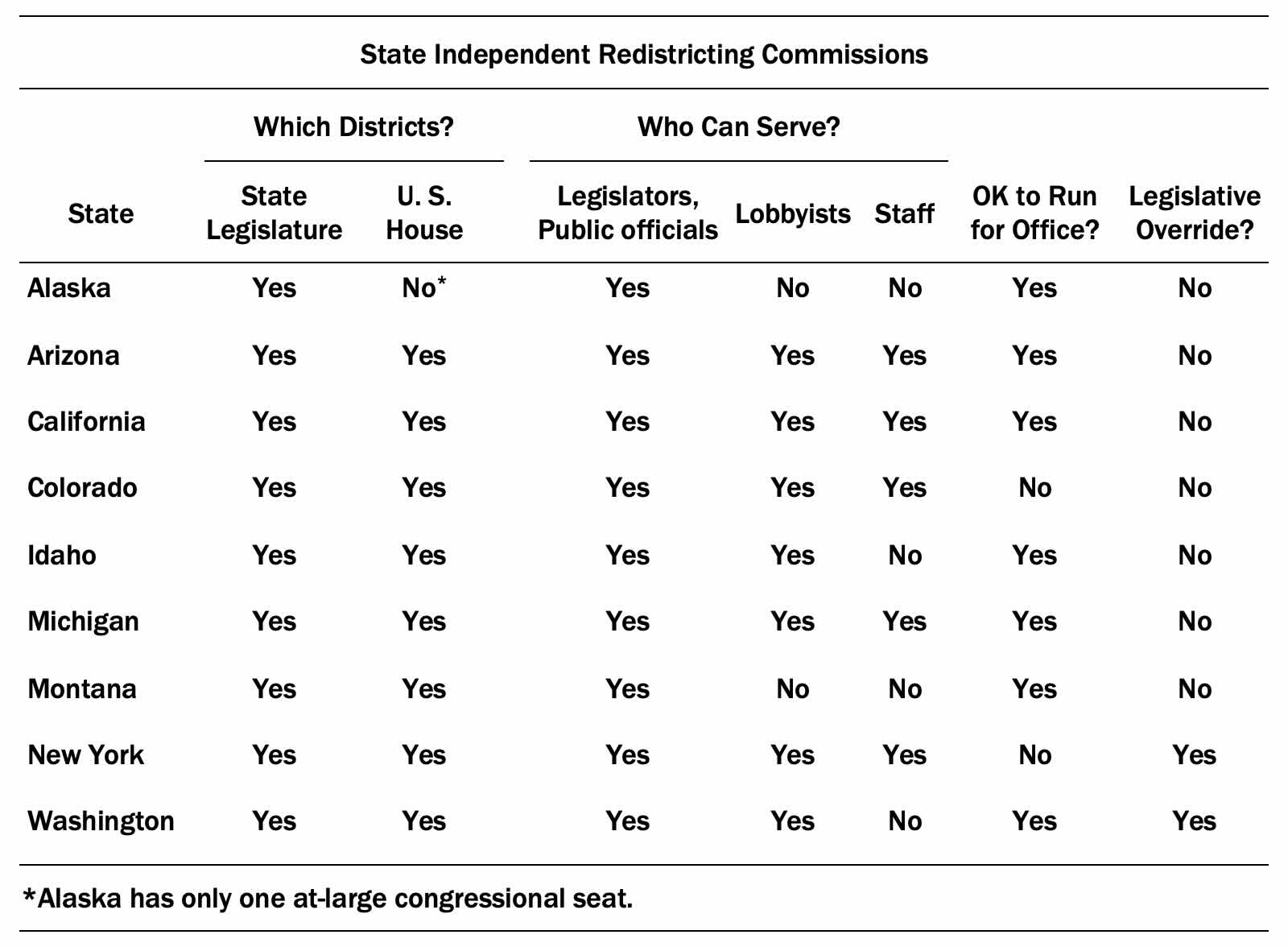What you need to know
In most states, politicians are responsible for the redistricting process, but in other states, independent redistricting commissions are utilized. How do independent commissions operate? What is their impact on the redistricting process?
- States control redistricting, and processes vary.
- Independent commissions are intended to reduce political bias in redistricting.
- Courts have upheld commissions, though controversies remain over their fairness, independence, and overall impact.
Who controls redistricting?
The U.S. Constitution requires congressional districts be revised every 10 years following the decennial Census. It leaves the details of redistricting up to the states. Most state legislatures control redistricting, giving politicians direct power to shape districts that may favor their own party. Independent redistricting commissions are an alternative.
As of 2025, nine states (Alaska, Arizona, California, Colorado, Idaho, Michigan, Montana, New York, and Washington) use independent commissions to draw congressional and state districts. Members of these commissions cannot be legislators or public officials. Many states go further, barring commissioners from running for office, working as lobbyists, or serving as legislative staff.

What do independent commissions do differently?
Independent commissions are designed to insulate the process from partisanship. For example, California’s Citizens Redistricting Commission was approved by voters in 2008, with the goal of removing map-drawing from politicians’ hands. In 2021, the commission unanimously approved new congressional maps after holding dozens of public hearings and inviting citizen input.
Commissions vary in style and oversight. In Michigan, commission members are selected from a pool of applicants by lottery, with strict rules that exclude recent candidates, lobbyists, and relatives of elected officials. New York and Washington allow their legislatures to override commission-drawn maps with a supermajority vote. In some states, members of redistricting commissions are chosen by partisan actors. In others, redistricting plans are subject to oversight or approval from a legislature.
Why do commissions occasionally face political pushback?
Advocates argue that commissions restore fairness and public trust. Representative Zoe Lofgren (D-CA) and others have repeatedly introduced the Redistricting Reform Act, which would require every state to adopt independent commissions. House Democrats included similar provisions in the 2021 For the People Act (H.R. 1).
However, not everyone agrees that commissions deliver fair outcomes. In New York, critics argue that the state’s independent redistricting commission has failed to prevent partisan maneuvering. Courts recently ordered New York’s commission to redraw its maps again, underscoring the ongoing struggle to balance independence with legislative oversight.
California’s redistricting model has been praised by some. Recently, however, Governor Gavin Newsom has proposed a 2025 ballot initiative (Proposition 50) that would temporarily suspend the state’s independent redistricting commission for congressional map drawing, and instead allow the state legislature to adopt new maps directly. The new maps would apply for the 2026, 2028 and 2030 U.S. House elections, giving California’s state legislature more direct authority mid-cycle. This move is being framed as a response to Republican redistricting efforts in Texas, which some view as partisan map changes. If passed, California’s independent commission's map-making authority would be restored after the 2030 census. Debate exists about whether Proposition 50 is constitutional and whether bypassing the commission undermines the original intent of voter-approved redistricting reforms.
The Takeaway
Independent commissions limit, but do not eliminate, the role of politics in redistricting.
Enjoying this content? Support our mission through financial support.
Further reading
New York Court of Appeals. (2023). Matter of Hoffmann v. New York State Independent Redistricting Commission, et al., 90 N.Y.3d 2023. https://tinyurl.com/ynznkr9k, accessed 9/8/2025.
Astudillo, C. (2025). “Lawmakers redrew Texas’ congressional districts. See how yours changed..” The Texas Tribune. https://tinyurl.com/43c45twk, accessed 9/8/2025.
Sources
State of Michigan. (2025). Random selection process. Michigan Independent Citizens Redistricting Commission. https://tinyurl.com/ycyxcawz, accessed 9/8/2025.
Li, M. (2002). What went wrong with New York’s redistricting Brennan Center for Justice. https://tinyurl.com/hpajd9xb, accessed 9/8/2025.
Doug Spencer's Guide to Drawing the Electoral Lines. (2025). Who draws the lines? https://tinyurl.com/bdw7kuwb, accessed 9/8/2025.
2020 California Citizens Redistricting Commission. (2025). About Us. https://tinyurl.com/ycy52x9c, accessed 9/8/2025.
Cornfield, J. (2025). Federal appeals court affirms Washington’s redrawn legislative district map Washington State Standard https://tinyurl.com/49rrjehx, accessed 9/8/2025.
Hardy, S. (2023). Election administration in constitutional trouble? An investigation into partisanship requirements. Columbia Human Rights Law Review. https://tinyurl.com/ykbnzckz, accessed 9/8/2025.
City of Long Beach. (2025). About the commission. https://tinyurl.com/5exm4jnm, accessed 9/8/2025.
Lofgren, Z. (2015). House Democrats introduce redistricting reform legislation to end partisan gerrymandering. U.S. House of Representatives. https://tinyurl.com/ycyn7y5j, accessed 9/8/2025.
U.S. Congress. (2021). H.R.1 – For the People Act of 2021. 117th Congress. https://tinyurl.com/t8ubh8ky, accessed 9/8/2025.
Yeoman, B. (2017). North Carolina’s gerrymandering puts democracy on the line. The Nation. https://tinyurl.com/v5hcujst, accessed 9/8/2025.
Brennan Center for Justice. (2025). Gerrymandering & fair representation. https://tinyurl.com/3puub6j9, accessed 9/8/2025.
Contributors
Lindsey Cormack (Content Lead) is an Associate Professor of Political Science at Stevens Institute of Technology and the Director of the Diplomacy Lab. She received her PhD from New York University. Her research explores congressional communication, civic education, and electoral systems. Lindsey is the creator of DCInbox, a comprehensive digital archive of Congress-to-constituent e-newsletters, and the author of How to Raise a Citizen (And Why It’s Up to You to Do It) and Congress and U.S. Veterans: From the GI Bill to the VA Crisis. Her work has been featured in The New York Times, The Washington Post, Bloomberg Businessweek, Big Think, and more. With a drive for connecting academic insights to real-world challenges, she collaborates with schools, communities, and parent groups to enhance civic participation and understanding.
William Bianco (Research Director) is Professor of Political Science at Indiana University and Founding Director of the Indiana Political Analytics Workshop. He received his PhD from the University of Rochester. His teaching focuses on first-year students and the Introduction to American Government class, emphasizing quantitative literacy. He is the co-author of American Politics Today, an introductory textbook published by W. W. Norton, now in its 8th edition, and authored a second textbook, American Politics: Strategy and Choice. His research program is on American politics, including Trust: Representatives and Constituents and numerous articles. He was also the PI or Co-PI for seven National Science Foundation grants and a current grant from the Russell Sage Foundation on the sources of inequalities in federal COVID assistance programs. His op-eds have been published in The Washington Post, Indianapolis Star, Newsday, and other venues.









